Test: JEE Main 35 Year PYQs- Electrostatics - JEE MCQ
30 Questions MCQ Test - Test: JEE Main 35 Year PYQs- Electrostatics
The nuclear charge (Ze) is non-uniformly distributed within a nucleus of radius R. The charge density ρ (r) [charge per unit volume] is dependent only on the radial distance r from the centre of the nucleus as shown in figure The electric field is only along the radial direction.
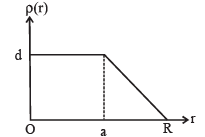
Q. The electric field at r = R is

The nuclear charge (Ze) is non-uniformly distributed within a nucleus of radius R. The charge density ρ (r) [charge per unit volume] is dependent only on the radial distance r from the centre of the nucleus as shown in figure The electric field is only along the radial direction.

Q. For a = 0, the value of d (maximum value of ρ as shown in the figure) is –

The nuclear charge (Ze) is non-uniformly distributed within a nucleus of radius R. The charge density ρ (r) [charge per unit volume] is dependent only on the radial distance r from the centre of the nucleus as shown in figure The electric field is only along the radial direction.

Q. The electric field within the nucleus is generally observed to be linearly dependent on r. This implies.

Consider an evacuated cylindrical chamber of height h having rigid conducting plates at the ends and an insulating curved surface as shown in the figure. A number of spherical balls made of a light weight and soft material and coated with a conducting material are placed on the bottom plate. The balls have a radius r <<h. Now a high voltage source (HV) is connected across the conducting plates such that the bottom plate is at +V0 and the top plate at –V0. Due to their conducting surface, the balls will get charged, will become equipotential with the plate and are repelled by it. The balls will eventually collide with the top plate, where the coefficient of restitution can be taken to be zero due to the soft nature of the material of the balls. The electric field in the chamber can be considered to be that of a parallel plate capacitor.
Assume that there are no collisions between the balls and the interaction between them is negligible. (Ignore gravity)
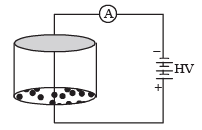
Q. Which one of the following statements is correct?
Consider an evacuated cylindrical chamber of height h having rigid conducting plates at the ends and an insulating curved surface as shown in the figure. A number of spherical balls made of a light weight and soft material and coated with a conducting material are placed on the bottom plate. The balls have a radius r <<h. Now a high voltage source (HV) is connected across the conducting plates such that the bottom plate is at +V0 and the top plate at –V0. Due to their conducting surface, the balls will get charged, will become equipotential with the plate and are repelled by it. The balls will eventually collide with the top plate, where the coefficient of restitution can be taken to be zero due to the soft nature of the material of the balls. The electric field in the chamber can be considered to be that of a parallel plate capacitor.
Assume that there are no collisions between the balls and the interaction between them is negligible. (Ignore gravity)

Q. The aver age current in the steady state registered by the ammeter in the circuit will be
STATEMENT-1 : For practical purposes, the earth is used as a reference at zero potential in electrical circuits. and
STATEMENT-2 : The electrical potential of a sphere of radius R with charge Q uniformly distributed on the surface is given by 
On moving a charge of 20 coulomb by 2 cm, 2 J of work is done, then the potential difference between the points is
If there are n capacitors in parallel connected to V volt source, then the energy stored is equal to
A charged particle q is placed at the centre O of cube of length L (A B C D E F G H). Another same charge q is placed at a distance L from O. Then the electric flux through ABCD is

If a charge q is placed at the centre of the line joining two equal charges Q such that the system is in equilibrium then the value of q is
Capacitance (in F) of a spherical conductor with radius 1 m is
If the electric flux entering and leaving an enclosed surface respectively is φ1 and φ2 , the electric charge inside the surface will be
A sheet of aluminium foil of negligible thickness is introduced between the plates of a capacitor. The capacitance of the capacitor
A thin spherical conducting shell of radius R has a charge q. Another charge Q is placed at the centre of the shell. The electrostatic potential at a point P a distance R/2 from thecentre of the shell is
The work done in placing a charge of 8 × 10-18 coulomb on a condenser of capacity 100 micro-farad is
Three charges –q1 , +q2 and –q3 are place as shown in the figure. The x - component of the force on –q1 is proportional to
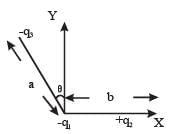
The length of a given cylindrical wire is increased by 100%. Due to the consequent decrease in diameter the change in the resistance of the wire will be
Two spherical conductors B and C having equal radii and carrying equal charges on them repel each other with a force F when kept apart at some distance. A third spherical conductor having same radius as that B but uncharged is brought in contact with B, then brought in contact with C and finally removed away from both. The new force of repulsion between B and C is
A charge particle ‘q’ is shot towards another charged particle ‘Q’ which is fixed, with a speed ‘v’. It approaches ‘Q’ upto a closest distance r and then returns. If q were given a speed of ‘2v’ the closest distances of approach would be
Four charges equal to -Q are placed at the four corners of a square and a charge q is at its centre. If the system is in equilibrium the value of q is
A charged oil drop is suspended in a uniform field of 3×104 v/m so that it neither falls nor rises. The charge on the drop will be (Take the mass of the charge = 9.9×10–15 kg and g = 10 m/s2)
Two point charges + 8q and – 2q are located at x = 0 and x = L respectively. The location of a point on the x axis at which the net electric field due to these two point charges is zero is
Two thin wire rings each having a radius R are placed at a distance d apart with their axes coinciding. The charges on the two rings are +q and -q. The potential difference between the centres of the two rings is
A parallel plate capacitor is made by stacking n equally spaced plates connected alternatively. If the capacitance between any two adjacent plates is ‘C’ then the resultant capacitance is
A charged ball B hangs from a silk thread S, which makes an angle θ with a large charged conducting sheet P, as shown in the figure. The surface charge density σ of the sheet is proportional to

A fully char ged capacitor has a capacitan ce ‘C’. It is discharged through a small coil of resistance wire embedded in a thermally insulated block of specific heat capacity ‘s’ and mass ‘m’. If the temperature of the block is raised by ‘ DT ’, the potential difference ‘V’ across the capacitance is
An electric dipole is placed at an angle of 30° to a nonuniform electric field. The dipole will experience
Two insulating plates are both uniformly charged in such a way that the potential difference between them is V2 – V1 = 20 V. (i.e., plate 2 is at a higher potential). The plates are separated by d = 0.1 m and can be treated as infinitely large. An electron is released from rest on the inner surface of plate 1. What is its speed when it hits plate 2? (e = 1.6 × 10–19 C, me = 9.11 × 10–31 kg)
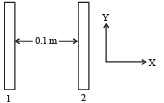
Two spherical conductors A and B of radii 1 mm and 2 mm are separated by a distance of 5 cm and are uniformly charged. If the spheres are connected by a conducting wire then in equilibrium condition, the ratio of the magnitude of the electric fields at the surfaces of spheres A and B is
An electric charge 10–3 μ C is placed at the origin (0, 0) of X – Y co-ordinate system. Two points A and B are situated at  and (2, 0) respectively. The potential difference between the points A and B will be
and (2, 0) respectively. The potential difference between the points A and B will be



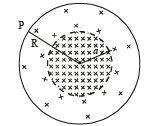

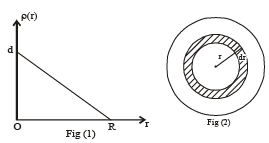








 but in opposite directions. Therefore the resultant is zero.
but in opposite directions. Therefore the resultant is zero.









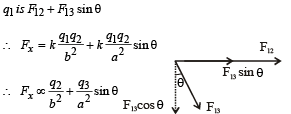











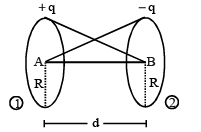

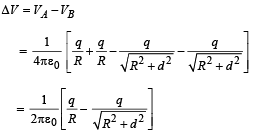
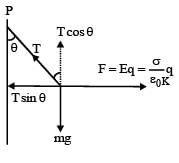


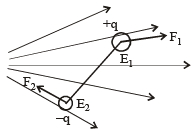





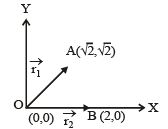
 from the origin,
from the origin,













